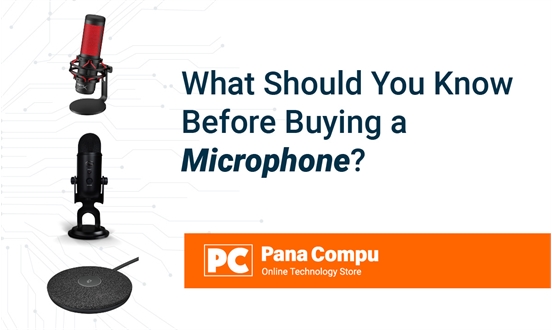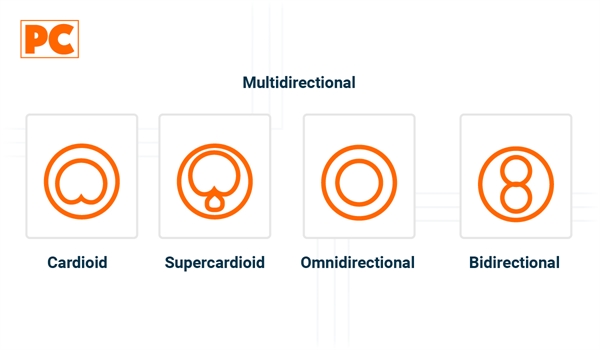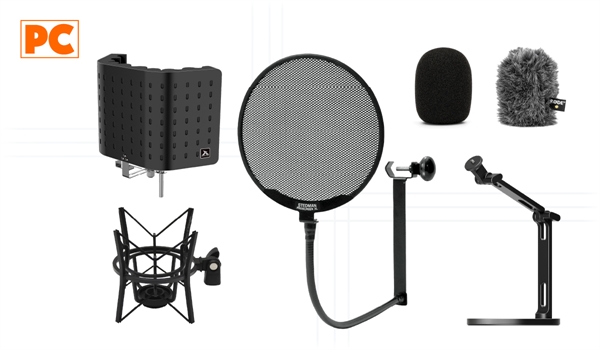What Should You Know Before Buying a Microphone?
Choosing the right microphone can be a challenging task if you are not familiar with the different types and features available. Whether you need it for home recording, live streaming, or podcasting, understanding the specifications and uses of each type of microphone is key to achieving professional, clean sound.

Microphone technology has evolved tremendously since its inception. Today, we not only have a variety of brands and models, but also different types of transduction and polar patterns, each designed to meet specific needs. But what really makes a microphone ideal for your purposes? It's not just about sound quality. Factors such as the recording environment, the type of sound source, ease of use, portability, and even budget play a crucial role. In this blog, we will explore what you should consider before buying a microphone.
When considering purchasing a microphone, don’t forget that quality audio is essential for any type of recording, streaming, or communication. A great microphone can significantly improve your sound, but for a complete listening experience, you’ll also need a good pair of headphones or a headset. To learn more about how to select the best complementary audio equipment, we invite you to read our guide on How to Choose the Perfect Headset. In this blog, you’ll find useful tips on the features you should consider and how to choose the ideal headset to suit your needs, whether for gaming, recording, or simply enjoying high-quality music.
What are the Types of Microphones?
When we talk about microphones, there is no one-size-fits-all solution. Each type of microphone has its own sound characteristics, sensitivity, and optimal application. The types of microphones are:

Dynamic Microphones
Dynamic microphones are robust, durable, and adapt well to a wide range of applications, especially for live performances and vocal recordings in noisy environments. They use a lightweight diaphragm and a moving coil that moves within a magnetic field to convert sound waves into an electrical signal. Additionally, they are less sensitive to external sounds and feedback, making them an excellent choice for live performances. That is, they can handle very high levels of sound pressure without distortion, ideal for drums, guitar amplifiers, and powerful vocals, among others.
Condenser Microphones
These microphones are more sensitive than dynamic ones and offer high-fidelity audio quality, capturing a greater range of frequencies and details in sound. They operate with a metal diaphragm that vibrates near a charged plate, creating an electrical signal through capacitance variation. These microphones are available in various patterns to adapt to different recording situations. As a downside, they can capture ambient noise if not used properly. They are ideal for studio vocal recording (singing, podcasts, voice-overs), acoustic and orchestral instruments, or recordings in controlled environments where maximum fidelity is sought.
Ribbon Microphones
Less common, ribbon microphones capture a warm, natural sound, perfect for studio recordings of instruments and vocals. These microphones use a thin metal ribbon suspended in a magnetic field that moves with sound waves, generating an electrical signal. Although they are delicate, their audio quality is exceptional and they are the preferred choice of many sound engineers. However, the ribbon can be easily damaged by gusts of air or knocks and only has a bidirectional polar pattern, which limits its use for sound sources in front and behind. These microphones are ideal for recording acoustic instruments like violins, pianos, or wind instruments, even for studio vocals for a vintage sound.
USB Microphones
USB microphones are microphones that connect directly to a computer or device via a USB port. Internally, these microphones contain an analog-to-digital converter (ADC), allowing the digital audio signal to be transmitted directly through the USB cable without the need for a separate audio interface. They are ideal for producers on the go or for temporary setups that are more budget-friendly. As a downside, typically some models may sacrifice build quality for price, and there may be a slight delay in audio input due to internal conversion and processing, although this has significantly improved over time and technology. In this section, we recommend exploring more about the HyperX QuadCast Microphone. This device has gained recognition for its versatility, ease of use, and sound quality. For a detailed overview of its features and how it can transform your audio setup, don’t miss our in-depth analysis in the blog 'Review: HyperX QuadCast Microphone'.
What are the key factors to consider before buying a Microphone?
Before buying a microphone, considering certain key factors will help ensure that the equipment meets your quality and functionality expectations. These are the essential aspects:
What will be the main use of the Microphone?
To recommend the most suitable type of microphone, it is essential to first identify the main use for which the microphone will be intended. The choice of microphone will directly depend on the main use it is meant for. It is crucial to consider not only the type of sound you want to capture but also the environment, the required mobility, the necessary audio quality, and how the microphone will integrate with the existing equipment or the ease of its setup. For every situation, there is a microphone that fits best, and the right choice can make a significant difference in the quality and effectiveness of your work or project. Here is a list of common uses and the types of microphones generally recommended for each:
- For Podcast or Streaming? USB or condenser microphones with USB interface are recommended. This is due to their ease of use and plug-and-play setup. Condenser microphones provide excellent voice capture, and USB models eliminate the need for additional equipment like audio interfaces.
- For Voice Recording in a Studio? The recommendation is large diaphragm condenser microphones as they provide high sensitivity and detailed capture of the nuances of the human voice. Ideal for capturing subtleties in tone and emotions.
- For Music Recording in a Studio? In this section, it is most advisable to mix between microphones. For vocals, large diaphragm condenser microphones are best because they capture a wide range of frequencies with clarity and detail. For acoustic instruments, condenser or ribbon microphones are preferred as ribbon microphones provide a natural, warm sound, while condensers capture the resonance and ambiance of the instrument. Meanwhile, for high-energy instruments like drums or electric guitars, dynamic microphones are recommended for being robust and able to handle high sound pressure levels without distorting.
- For Video Conferences and Calls? USB microphones or small condenser microphones with USB adapters are ideal due to their ease of use, improving audio quality without technical complications.
What is your available budget?
Determining your budget is a crucial step before deciding on a microphone, as costs can vary greatly depending on quality, brand, features, and type of microphone you are looking for. Here are some considerations and options according to different budget ranges:
- Budget Microphones: In this range, you will find USB microphones designed for beginners or casual users. These microphones are ideal for small voice recordings, basic podcasts, or online communications. If you need something small and portable for interviews or presentations, some wireless or lavalier microphones can be found in this range. They usually fall below 50 dollars.
- Mid-Range Microphones: Here you can find microphones like the Blue Yeti or the HyperX QuadCast Microphone, which offer superior sound quality for podcasters, streamers, or home singers. These microphones tend to have better polar patterns and noise reduction. This price range can be between 50 and 200 dollars.
- High-End Microphones: In this range, you can invest in large diaphragm condenser microphones that are the choice of many professional studios. You can also find ribbon microphones specialized for recording instruments with a vintage sound, or small diaphragm condenser microphones for stereo recording applications. This range includes prices between 200 and 500 dollars.
What are Polar Patterns and which one should the Microphone have?
Polar patterns are a crucial feature of microphones that define how they respond to surrounding sound sources. Each polar pattern has its own "listening area," determining from which directions the microphone will capture sound most effectively. Understanding and choosing the right polar pattern for your recording situation can mean the difference between a clear, focused recording and one that is filled with unwanted background noise or fails to capture the ambiance you are looking for. Here are the main polar patterns and in what contexts they are best used:

- Cardioid: This pattern has a heart shape (hence its name), being more sensitive to sounds coming directly in front of the microphone, and rejecting sounds from the sides and rear. It is the most versatile and commonly found pattern. Ideal for recording voices in studio or live, solo instruments, podcasting, and streaming.
- Supercardioid or Hypercardioid: These patterns are more directional than cardioid, with a narrower frontal pickup angle and a small rear pickup area. The supercardioid has a wider rear lobe than the hypercardioid. Used when greater directionality is needed to isolate the sound source from the environment, such as in live concerts for specific instruments or in situations where there is a lot of background noise.
- Omnidirectional: Captures sound from all directions uniformly. This polar pattern has no preferred direction. It is used in ambient recordings, to capture the sound of an entire room or in conferences where sound from any part of the room is wanted.
- Bidirectional: Captures sound from both in front and behind the microphone, with a rejection zone at the sides. This pickup shape is similar to the figure of an "8". Perfect for stereo recordings with two microphones, face-to-face interviews, vocal duets, or instruments that you want to capture from both sides, like a piano or an acoustic guitar.
- Multidirectional: Some microphones, especially high-end condenser microphones, offer the ability to switch between several polar patterns. The ability to change the polar pattern makes these microphones extremely versatile. They can be used in different situations without needing to change microphones, which is ideal in recording studios or for producers working on multiple projects. The Blue Yeti or HyperX Quadcast are known for their ability to switch between cardioid, bidirectional, omnidirectional, and figure-eight.
What is Impedance and how does it affect a Microphone?
Impedance is a term that refers to the resistance that an electrical circuit offers to the flow of alternating current. In the context of microphones, impedance can significantly affect how audio signals are transmitted and handled. Low impedance (less than 600 ohms) helps maintain a high signal-to-noise ratio, as stronger signals are less likely to be affected by electrical noise. Low impedance microphones can handle longer cables without significant signal degradation. In contrast, high impedance microphones may experience signal loss and noise if used with long cables. For most applications, low impedance is the preferred option due to its better signal handling and lower susceptibility to interference.
What is Frequency Range and how can it affect the sound of the Microphone?
The frequency range of a microphone refers to the spectrum of audio frequencies that the microphone can effectively capture. It is expressed as an interval from the lowest frequency to the highest that the microphone can faithfully capture. Human hearing generally spans from about 20 Hz to 20,000 Hz (20 kHz), although this ability can vary between individuals and decreases with age. A microphone with a wide frequency range will capture more details of sound, providing a truer representation of the sound source.
- Low Frequencies: Microphones that perform well in low frequencies will better capture the bass of instruments like bass, drums, or the ambient sound of a large room.
- High Frequencies: A microphone that captures high frequencies well will be ideal for bright instruments like cymbals, high-pitched voices, or the high resonance of string instruments.
How important is noise cancellation in a microphone?
Noise cancellation in a microphone plays a crucial role in the quality and clarity of audio recordings or broadcasts. In environments where background noise is inevitable, such as busy streets, noisy offices, or during outdoor events, this technology helps isolate the main sound source, whether it be a voice or an instrument, from the background noise. This results in a cleaner and more focused recording, which is essential for understanding the message or appreciating the music. Noise cancellation technology can be of two types: passive and active. Passive noise cancellation uses physical materials to block noise, while active noise cancellation (ANC) employs digital algorithms or circuits to generate a signal that cancels out noise. Active cancellation is usually more effective but can also be more expensive and complex.
The improvement in the signal-to-noise ratio provided by noise cancellation is one of its most significant advantages. When a microphone can attenuate or eliminate background noise, the useful signal (your voice or music) stands out more, dramatically improving audio quality. This is particularly useful in videoconferencing, podcasts, and any type of voice transmission where clear communication is required without distractions. Although noise cancellation is fundamental for achieving clarity in recordings or broadcasts where noise is an issue, it must be balanced with other microphone characteristics to ensure the sound source is reproduced optimally.
What should you consider before choosing a Microphone for Conferences?
With the rise of virtual meetings and remote work, having a good microphone for video conferencing is key to ensuring clear and professional communication. For individual meetings, a cardioid or condenser microphone is a great option. For groups, an omnidirectional microphone or a speaker with an integrated microphone is better. If you work with different devices, a microphone with USB and Bluetooth connectivity will simplify setup. For shared or noisy workspaces, it is essential that the microphone has some noise reduction technology to improve clarity on the call. To indicate the essential features in a conference microphone, we list them below:

- Clear and Consistent Voice Quality: In a video conference, voice clarity is paramount. The microphone should capture full, natural voice tones without distortion, allowing interlocutors to hear you without issues, even in long sentences or somewhat noisy environments.
- Omnidirectional or Cardioid Polar Pattern:
- If you are alone, a cardioid microphone that captures front sound is ideal, as it avoids unwanted noise from other angles.
- For meeting rooms or video conferences with several people, an omnidirectional microphone may be better, as it picks up sound from all directions, allowing all participants to hear clearly.
- Noise Cancellation: Many microphones for video conferencing include noise cancellation technologies, which reduce background noise and emphasize the voice. This is especially useful in home office environments or open offices where ambient noise can be a distraction
- USB or Bluetooth Connectivity: USB connectivity is ideal for quick and reliable setup on computers, while Bluetooth or wireless connectivity is useful for workspaces that require mobility or more complex conference setups.
- Portability and Compact Size: A compact and portable design facilitates use and storage, especially if the microphone will be moved between different locations or used in small spaces.
What are the Most Common Accessories for Microphones?
Microphones can be very versatile tools, but their performance and functionality can be significantly enhanced with the use of the right accessories. Here are some of the most common and essential accessories for microphones:

- Microphone Stands: They come in various types, such as desktop stands ideal for podcasting or recordings at a desk, floor stands that are adjustable and perfect for live performances or studio recordings, and boom arms that offer great flexibility for positioning the microphone accurately, especially useful in professional recording environments where frequent adjustment is needed.
- Shock Mount: It is crucial for condenser microphones. Its function is to isolate the microphone from physical vibrations that could be picked up as unwanted noise. This is especially important in recording studios where movement or background noise could affect audio quality. The shock mount allows the microphone to "float" within a frame, thus reducing the transfer of vibrations.
- Pop Filter: The pop filter is a screen placed in front of the microphone to reduce explosive sounds from consonants like 'P' and 'B'. These filters are usually mesh or metal and prevent the breath's air from hitting directly onto the microphone diaphragm, which can cause distortions.
- Headphones: Headphones are essential for monitoring during recording or for communications in live situations. They allow you to hear the microphone signal in real-time, which is useful for adjusting position, volume, and avoiding feedback in live performances.
- Reflection Rings: To improve acoustics in vocal recordings, a reflection ring or hoop can be used to surround the recording area, helping to reduce unwanted reflections and improve the clarity of the recorded sound.
- Windshield: Windshields are used to minimize wind noise or breath sounds. There are two main types: foam, which is used in situations with a bit of wind or direct breath.
What are the Most Popular Microphone Brands?
In Latin America, the most popular microphone brands tend to be those that offer versatile, high-quality solutions, adapting to different user needs, from musicians and podcasters to audio professionals in studios and live productions. Some of the most recognized brands are:
- HyperX: Primarily known for its gaming products, it has expanded its range to microphones. Its focus is on the gaming and streaming community, offering microphones like the HyperX QuadCast that promise studio quality with features like gain control, selectable polar patterns, and an aesthetic design that fits streaming setups. They are popular for sound quality, ease of use, and features designed for digital content creators.
- Razer: The brand targets the eSports and streaming community, with microphones like the Razer Seiren that integrate well with their gaming product ecosystem. Razer focuses on offering microphones that provide clear audio output ideal for streaming, with additional features like RGB lighting, touch controls for mute and audio adjustments, and compatibility with software for customization.
- Blue Microphones: Although it is a brand more oriented towards consumers in the digital audio market, Blue Microphones, now part of Logitech, is known for high-quality microphones for streaming, voice recording, and podcasting, with the Yeti being one of the most iconic. With a range of accessible and high-quality USB microphones, such as the Blue Yeti and Blue Snowball, Blue is a favorite brand for podcasters, streamers, and those seeking sound quality without the need for additional equipment.
- Sennheiser: This brand offers a wide range of products from condenser microphones for studios to high-quality wireless solutions. They are leaders in wireless technology, and their microphones are used in both the entertainment industry and corporate environments. Sennheiser is a respected brand in both professional audio production and field recording
Where can you buy Microphones in Latin America?
In many countries in Latin America, there are stores dedicated exclusively to audio and music equipment where you can find a wide range of microphones. These stores often offer expert advice, local warranties, and sometimes the possibility of trying products before buying. These stores provide the advantage of physical purchasing, in-store testing, and financing options, although the selection may be more limited compared to specialized stores.

Where can you buy microphones in Peru?
As with laptops, importing microphones from markets like the United States or Europe can be an option to access specific models or lower prices. However, consider shipping costs, import taxes, and potential customs delays. Although Amazon does not have a full operation in Peru, you can find sellers who use this platform to sell. However, the most recommended option is to purchase your products in a tech store like Pana Compu, as products like microphones in Peru are available in the country and you do not have to think about additional expenses. They also have valid warranties on all products.
Where can you buy microphones in Panama?
In Panama, department stores have sections dedicated to audio equipment where you can find microphones of different brands and qualities. Additionally, they sometimes hold special events or technology and music fairs that can offer microphones at promotional prices or the opportunity to try them live. Although direct access to Amazon may be limited, the best option is to buy locally online from Pana Compu, which offers online sales with fast delivery options. Buying microphones in Panama becomes easy this way. Additionally, all their products come with valid warranties in Panama.
In summary: What Should You Know Before Buying a Microphone?
When deciding to buy a microphone, it is crucial to consider several factors to ensure that the investment aligns with your needs and intended use.
- First, identify what you will use the microphone for, whether for streaming, podcasting, conferences, professional music recording, or simply to improve audio quality in video calls. Each purpose may require a different type of microphone, whether dynamic, condenser, ribbon, or even a USB microphone for greater simplicity and portability.
- Second, budget plays an essential role. Although quality and price tend to go hand in hand, there are budget options that can offer surprisingly good performance for non-professional uses. However, if you seek professional quality, you will be willing to invest more in brands and models that have proven their worth in the market.
- Third, consider the polar pattern of the microphone, which defines how it picks up sound. Patterns like cardioid, omnidirectional, bidirectional, among others, affect the direction from which the microphone will collect sound, which is vital depending on whether you will be recording solo, in a group, or in a noisy environment. The choice of polar pattern can minimize unwanted noise and optimize the capture of your voice or instrument.
- Fourth,the build quality and included accessories can influence your decision. Quality microphones often come with pop filters, shock mounts, and sometimes even audio editing software. These accessories enhance the recording experience and protect your investment from wear and tear.
- Finally, compatibility with your current equipment and the technical support that the manufacturer or seller offers are aspects not to forget. Ensure that the microphone is compatible with your computer or audio system, and consider warranty and availability of technical assistance if something goes wrong.
Buying a microphone is not just a matter of brand or price; it is a decision that requires evaluating your specific needs, recording environment, and your level of technical experience. With this information in mind, you will be able to choose a microphone that not only meets your current expectations but also supports your future audio projects.
Comments
All opinions are of our customers friends. Join the conversation!
No comments yet... Be the first!